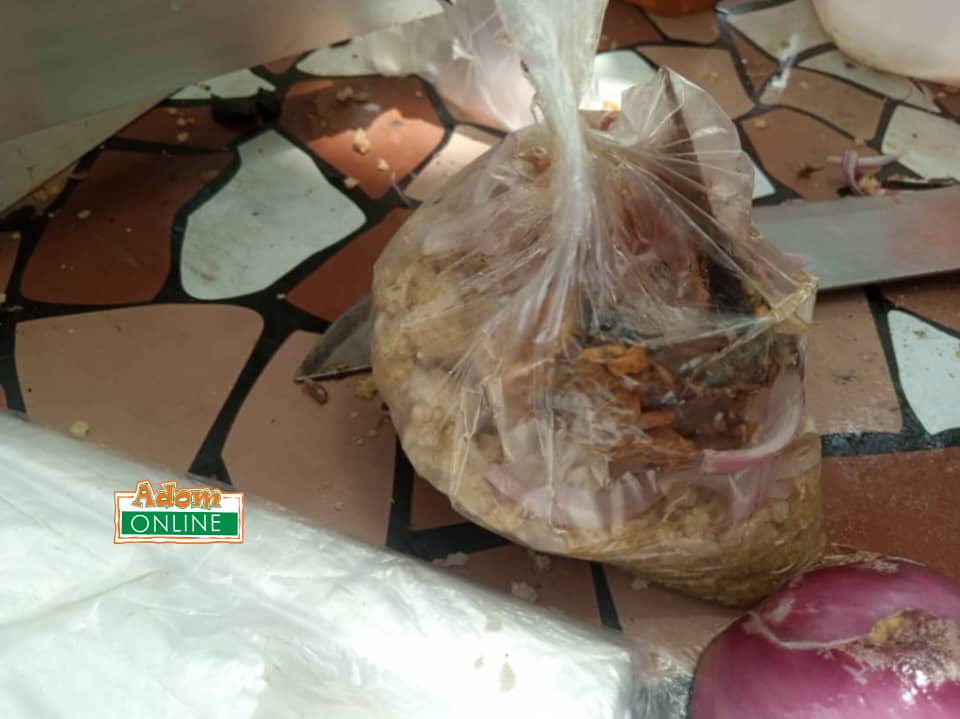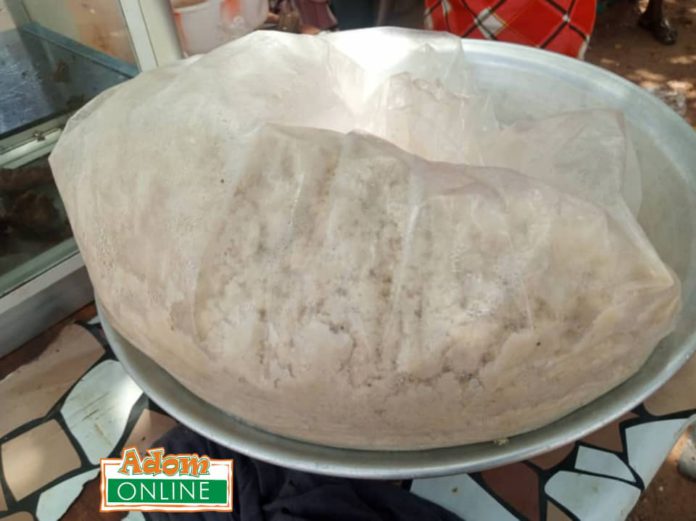AKYƐKƐ is a local gourmet highly patronized at Sampa, the Jaman North District capital in the Bono Region.
Prepared from cultured cassava puree that has been grated and steamed, it is the most delicious, energetic, and easy-to-get food at Sampa and its environs
The meal is widely prepared in the area has gained so much popularity over other local dishes such as fufu, banku, yoo-ke-gari (GOBƐ), and waakye.
On every corner one passes at Sampa, particularly the Sampa main station and market, one is sure to catch up with one akyɛkɛ vendor or joint.
In Ghana, akyɛkɛ is eaten mainly among the Nzema and people living on the border with Ivory Coast.
But the food is now gaining its roots in the Jaman North and South Municipalities of the Bono Region and becoming even more popular than most local delicacies.
An Akyɛkɛ consumer at Sampa, Francis Tanor said the akyɛkɛ prepared in the area tasted good as compared to other areas thus making it popular and one of the fastest-growing businesses in the area.
He said, his wife had bought a KIA Rhino for the cashew business through the Akyɛkɛ business, and she was supporting him financially to cater for their daughter at Sampa Nursing Training College.
Some of the taxi drivers at Goka, Berekum, and Kokoa stations said considering the economic hardship, they preferred to consume just 10 or 15 cedis of Akyɛkɛ to spend about 30 to 50 cedis on fufu.
The dish, which is uncommon in other parts of the region, is usually served with toasted tilapia or any other fried fish as well as salted, boiled eggs, meat, fried ripped plantain, avocados (pear), and spaghetti with oil and salt.
In addition, akyɛkɛ can be eaten with (optional) vegetables such as spicy pepper garnished with more sliced green pepper, cabbage, tomatoes, onions, and boiled beans as well as roasted groundnut.
Other sections of the public also prefer to enjoy it with stew, soup, or ground pepper and tomatoes.

As little as GHC5, one can buy a plate of akyɛkɛ, with the accompanied vegetables but without fish or an egg.
However, with GHC10, one could get a plate of the dish and all the vegetables, including the fried ripped plantain and roasted groundnut with either fish, egg, or meat.
Residents, particularly vendors said they adopted the meal from the neighboring Cote d’Ivoire.
A vendor, Esther Yeboah told Adom News that, the meal was popular and a traditional dish for the people in Ivory Coast.
Esther said aside from the fact that cashew business has improved the financial positions of families, the akyɛkɛ business is another jackpot for the women in the area.
According to her, she has been in the business for over 20 years and had built her own house, and her two children have gone to the university.
Explaining how the meal is prepared, she said the process was very simple and is not different from preparing gari.

Esther explained they peeled and washed cassava thoroughly and grated it into a paste, after which they drained excess water content from the paste. The paste is ferment and later dried in the sun for close to an hour.
She said a splatter guard is placed on top of boiling water with salt and placed on a ring baking pan mold, then poured the dried grated cassava onto the splatter guard and stirred continuously to avoid lumps. That is they applied the steaming method of cooking
The final cooking was done by steaming the pulp for about half an hour to get it ready for serving, adding that if not prepared well, the taste could be affected.
The akyɛkɛ lover, Dabie Johnson an autorickshaw (pragya) rider said the dish tasted great when eaten with all the accompaniments. He added that just a plate of the akyɛkɛ makes one satiated for the day.
Peter Nayir, a nutritionist said the akyɛkɛ is rich in carbohydrates and is gluten-free, which is a good diet for people suffering from celiac disease or gluten intolerance.
The akyɛkɛ is easily digestible and also regulates problems of diarrhea and gives free bowel. It also promotes brain function due to the glucose it it.
However, it’s essential to consume akyɛkɛ as a balanced diet and be mindful of portion sizes, especially for people managing conditions like obesity and diabetes due to its high content of starch and glucose.

